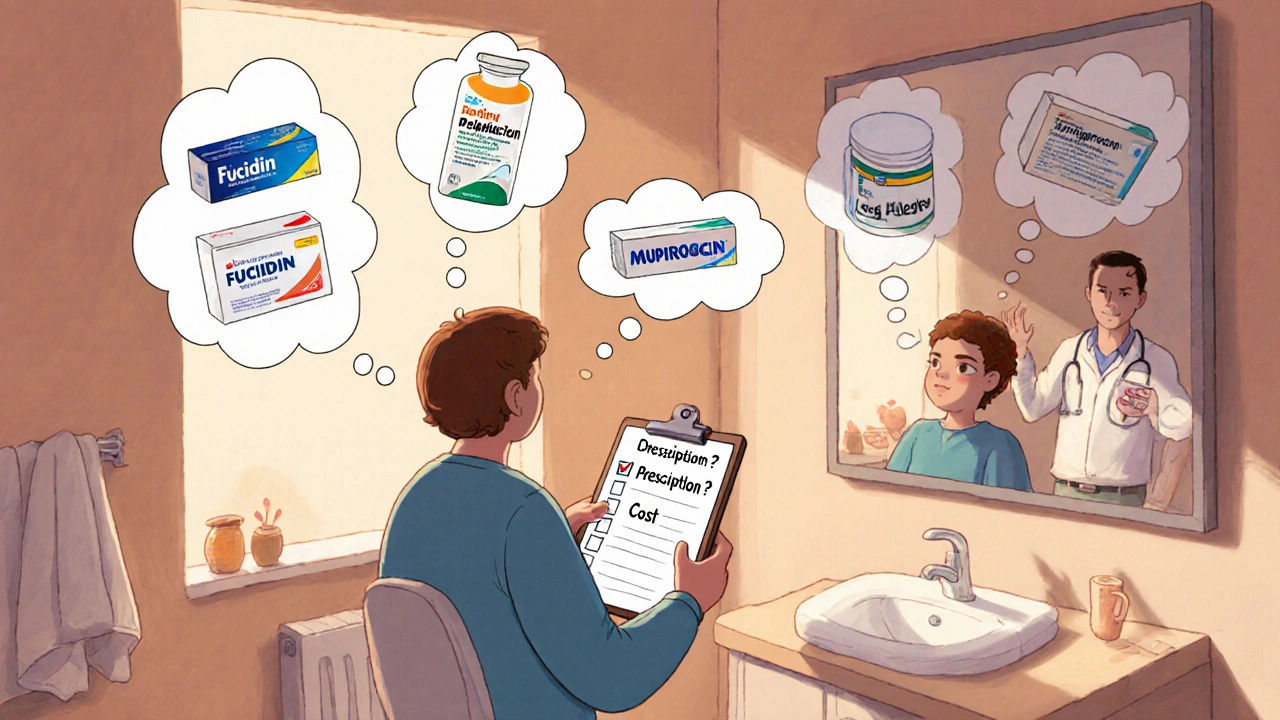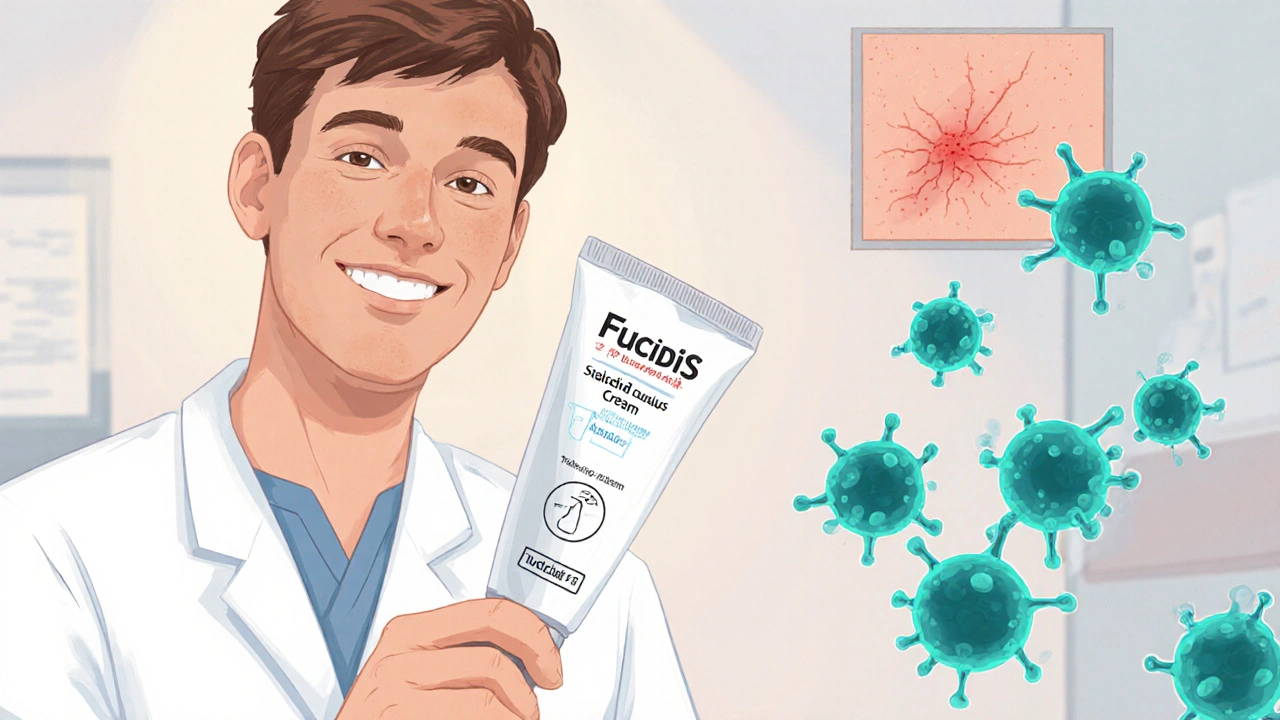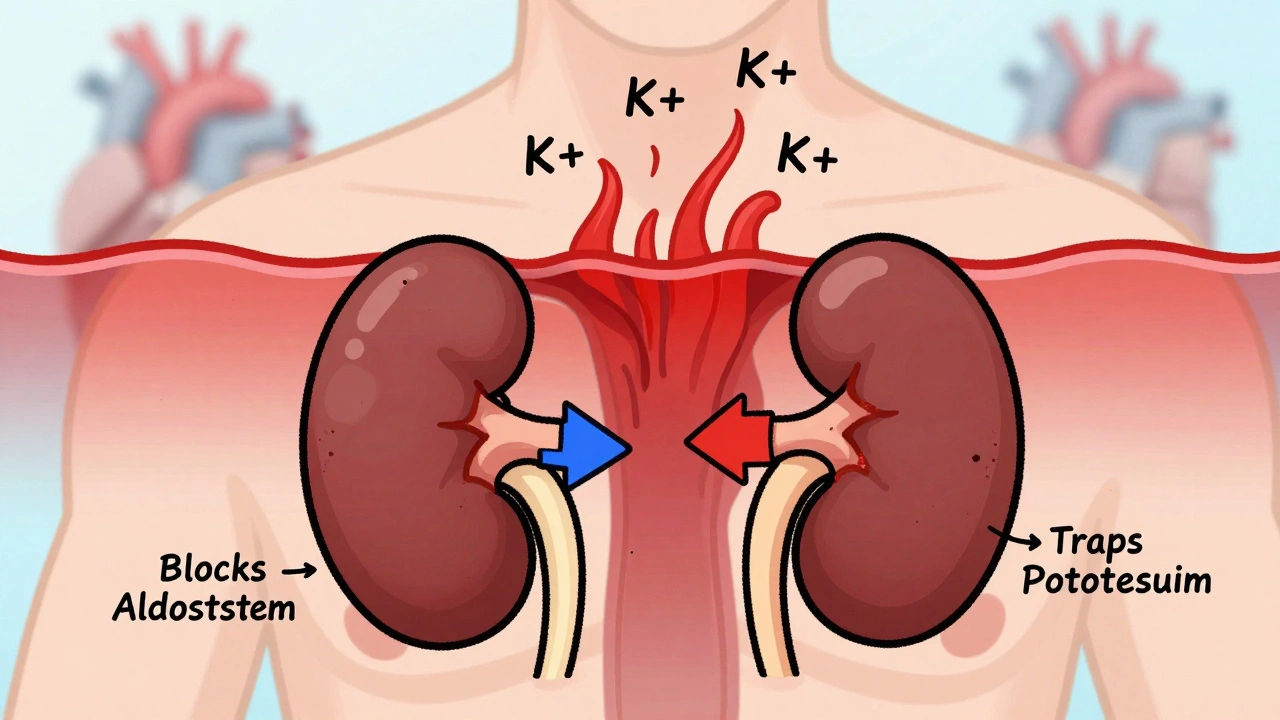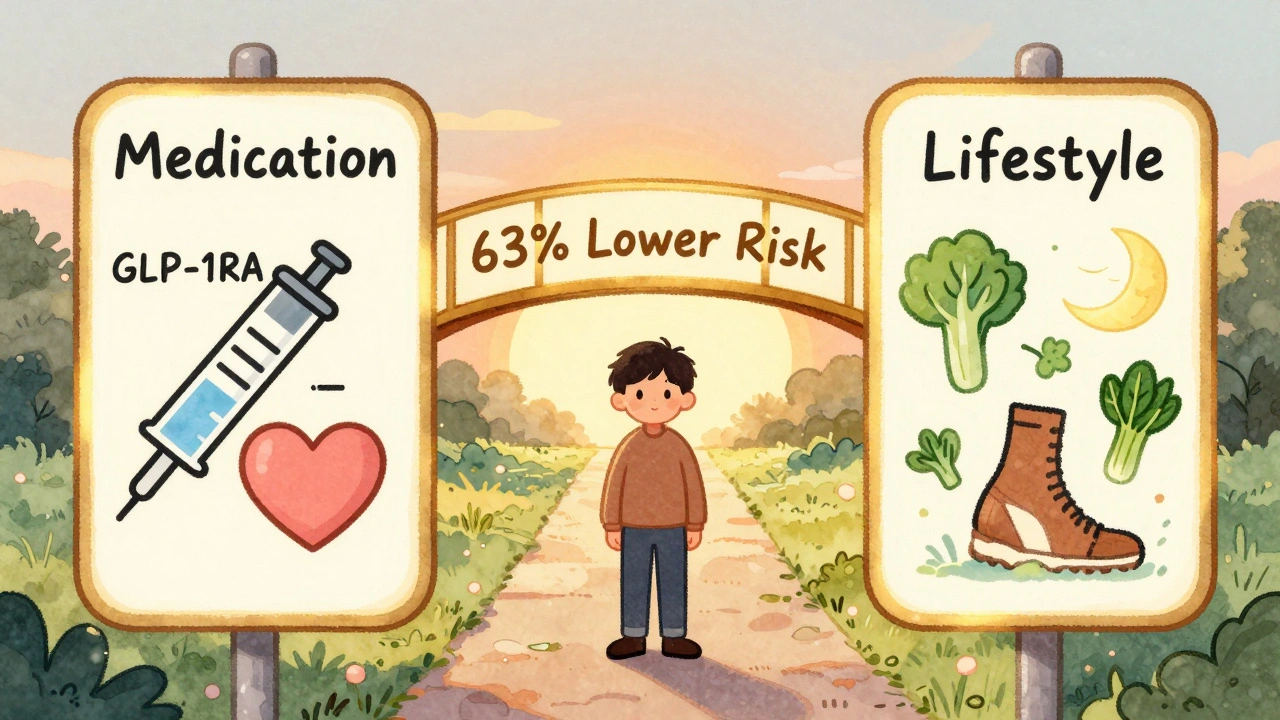Topical Antibiotic Selector
Which Antibiotic Is Best For You?
Answer a few questions to identify the most appropriate topical antibiotic for your skin condition.
Fucidin cream is a prescription‑only topical antibiotic that many people rely on for stubborn skin infections. If you’ve ever wondered how it stacks up against other ointments, you’re in the right spot. Below you’ll find a quick rundown, in‑depth looks at each product, a side‑by‑side table, and practical tips to pick the best option for your needs.
Quick Summary
- Fucidin (fusidic acid) targets Gram‑positive bacteria, especially Staphylococcus aureus.
- Common alternatives include mupirocin, clindamycin, neomycin and bacitracin.
- Choose based on infection type, resistance patterns, prescription status and cost.
- All topicals can cause irritation; watch for allergic reactions.
- Seek medical advice if the rash spreads, worsens, or shows systemic symptoms.
What Is Fucidin Cream?
Fucidin Cream is a topical antibiotic formulation containing 2% fusidic acid. Developed in the 1960s, fusidic acid is a steroid‑derived molecule that stops bacterial protein synthesis by locking the elongation factor G (EF‑G) on the ribosome. In the UK it is classified as a prescription‑only medicine (POM) and is marketed by Allergan.
Key attributes:
- Active ingredient: fusidic acid 2% (w/w)
- Form: cream (available also as ointment)
- Spectrum: primarily Gram‑positive cocci, notably S. aureus, including some MRSA strains
- Typical use: impetigo, infected eczema, minor wounds, folliculitis
- Resistance: low but increasing reports in community settings
How Fusidic Acid Works
Fusidic acid binds to the bacterial EF‑G after it has delivered a tRNA to the ribosome, preventing the complex from dissociating. This halts translocation, freezing protein synthesis and leading to bacterial death. Because the target is a bacterial‑specific factor, human cells are unaffected, which explains the drug’s good safety profile when used correctly.
When to Use Fucidin Cream
Doctors often prescribe Fucidin for localized infections where Staphylococcus is the suspected culprit. Clinical studies show cure rates of 80‑90 % after a five‑day course for mild to moderate impetigo. It’s less effective against Gram‑negative organisms like Pseudomonas aeruginosa, so a culture‑guided approach is best for mixed infections.
Topical Antibiotic Alternatives
Below are the most common substitutes you’ll encounter in UK pharmacies or clinics. Each has its own niche, strengths and drawbacks.
Mupirocin (Bactroban)
- Active ingredient: mupirocin 2% (cream) or 5% (ointment)
- Spectrum: broad Gram‑positive, excellent against MRSA
- Typical use: impetigo, secondary wound infections, nasal decolonisation
- Prescription status: POM in the UK
- Cost: higher than Fucidin, often reimbursed for chronic skin conditions
Clindamycin (Dermaclin)
- Active ingredient: clindamycin phosphate 1%
- Spectrum: anaerobes, some Gram‑positive bacteria
- Typical use: acne, infected eczema, bites
- Prescription status: POM, available over the counter in some lower concentrations
- Resistance: rising in acne‑related Propionibacterium
Neomycin (Bactroban‑Neomycin)
- Active ingredient: neomycin sulfate 0.5% (often combined with polymyxin B and bacitracin)
- Spectrum: Gram‑negative and some Gram‑positive
- Typical use: minor cuts, abrasions, burns
- OTC status: available without prescription in the UK
- Allergy risk: relatively high; contact dermatitis common
Bacitracin (Baciguent)
- Active ingredient: bacitracin zinc 500 IU/g
- Spectrum: mainly Gram‑positive cocci
- Typical use: superficial wounds, skin tears
- OTC status: widely sold in pharmacies
- Allergy risk: moderate; often combined with neomycin or polymyxin B
Side‑by‑Side Comparison
| Product | Active Ingredient(s) | Primary Spectrum | Typical Indications | Prescription Status (UK) | Cost (approx.) | Resistance Concerns |
|---|---|---|---|---|---|---|
| Fucidin Cream | Fusidic acid 2% | Gram‑positive (Staph) | Impetigo, infected eczema | POM | £8‑£12 per tube | Low, but emerging MRSA resistance |
| Mupirocin | Mupirocin 2% (cream) / 5% (ointment) | Broad Gram‑positive, MRSA | Impetigo, nasal decolonisation | POM | £15‑£20 per tube | Generally low, still best for MRSA |
| Clindamycin | Clindamycin phosphate 1% | Anaerobes, Gram‑positive | Acne, infected eczema | POM (OTC low strength) | £10‑£14 per tube | Increasing in acne‑related strains |
| Neomycin (combo) | Neomycin 0.5% + Polymyxin B + Bacitracin | Gram‑negative + Gram‑positive | Minor cuts, burns | OTC | £5‑£8 per tube | High allergy potential |
| Bacitracin | Bacitracin zinc 500 IU/g | Gram‑positive cocci | Superficial wounds | OTC | £4‑£7 per tube | Low resistance, but limited spectrum |
How to Choose the Right Topical
Think of the decision as a checklist rather than a guess:
- Identify the bug. If you have a confirmed Staph infection, Fucidin or mupirocin are prime picks. For mixed Gram‑negative wounds, a neomycin combo works better.
- Check resistance trends. In community‑acquired MRSA hotspots, mupirocin outranks fusidic acid.
- Consider prescription hurdles. OTC options (neomycin, bacitracin) are handy for quick fixes, but they may not clear deeper infections.
- Budget matters. A 10‑day course of Fucidin is cheaper than mupirocin, yet the latter may save a later doctor visit if it clears MRSA faster.
- Allergy profile. If you’ve reacted to neomycin before, steer clear of combo products that include it.
When in doubt, a short tele‑consult with your GP can narrow the choice without a full‑scale culture.

Safety, Side Effects, and Contra‑indications
All topicals share a few common warnings:
- Local irritation, redness or itching is normal in the first 24‑48 hours.
- Contact dermatitis is most frequent with neomycin and bacitracin blends.
- Systemic absorption is negligible, but large surface area applications should be monitored in infants.
- Pregnant or breastfeeding women should discuss use with a clinician; fusidic acid is generally considered low risk, but data are limited.
If you notice swelling, blistering, fever, or spreading redness, stop the cream and seek medical help promptly.
Application Tips for Best Results
- Wash hands and gently clean the affected skin with mild soap.
- Pat the area dry; excess moisture can dilute the ointment.
- Apply a thin layer (about the size of a pea) and rub it in gently.
- Cover with a sterile gauze only if the wound is open and at risk of contamination.
- Repeat the dosage as prescribed, typically twice daily for five days; don’t extend use without advice.
- Store the tube at room temperature, away from direct sunlight.
Following the regimen exactly reduces the chance of resistance and improves healing speed.
Frequently Asked Questions
Can I use Fucidin for fungal infections?
No. Fusidic acid targets bacteria, not fungi. For ringworm or yeast infections, an antifungal such as clotrimazole is needed.
How long does it take for a rash to clear with Fucidin?
Most patients see improvement within 48‑72 hours and complete resolution after five days of twice‑daily use, assuming the infection is uncomplicated.
Is it safe to apply Fucidin on children under two?
The UK label advises use only under medical supervision for children under two because skin permeability is higher. A pediatrician can weigh the benefits against any risk.
What should I do if the cream causes a rash?
Stop using the product immediately, rinse the area with water, and contact your GP. An allergic reaction may require a steroid cream or oral antihistamine.
Are there any drug interactions with fusidic acid?
Topical fusidic acid has minimal systemic absorption, so interactions are rare. However, if you’re using a lot of other topical antibiotics, overlapping sensitivities could arise.
Bottom line: Fucidin remains a solid first‑line choice for uncomplicated Staph skin infections, but alternatives like mupirocin or a neomycin combo may be better suited to specific bacteria, cost constraints, or prescription availability. Always match the drug to the infection, keep an eye on resistance trends, and don’t ignore skin irritation signals.







eric smith
October 21, 2025 AT 01:01Oh, look, another "expert" trying to sell you a cream like it's the Holy Grail of skin care. Let me break it down for you: Fusidic acid works great on staph, sure, but it’s not a miracle drug. If you’ve got a mixed infection, you’ll be back at the doc in a week anyway. The resistance numbers are creeping up, so you’re basically buying yourself a future problem. And guess what? The cost isn’t even that much cheaper than mupirocin when you factor in the extra visits. So before you jump on the Fucidin bandwagon, ask yourself if you really need a prescription‑only product for a simple impetigo. Spoiler: you probably don’t.
Devendra Tripathi
October 22, 2025 AT 09:33Your love‑letter to fusidic acid is nothing but corporate hype.
Nick M
October 23, 2025 AT 18:05Listen, the pharma lobby doesn’t want you to question the so‑called "standard of care". They pump out studies that hide the fact that Fusidic acid resistance is a ticking time bomb, especially when people use it over the counter in off‑label ways. The micro‑flora in your skin is a complex ecosystem, and slapping a broad‑spectrum antibiotic on it without a culture is akin to blowing up a building to kill a mouse. Also, the “low systemic absorption” claim is a myth – the skin barrier gets bypassed with large surface area applications, especially on kids. Bottom line: demand a culture, demand a rationale, or you’ll be feeding the resistance machine.
Ericka Suarez
October 25, 2025 AT 02:37Yo, stop acting like you own the whole med world. Fucidin is not the only gun in the holster and you cant just blast it on every rash. If the infection is gram‑negative, you’ll get nothing but a rash. And dont forget, the British healthcare system ain’t the same as the US, so pricing and availability change. Get a proper diagnosis before you go throwing creams around, or you’ll just waste money and time.
Casey Cloud
October 26, 2025 AT 10:09Alright, let’s cut through the noise and give you a practical roadmap for picking the right topical antibiotic. First, identify the likely pathogen – most uncomplicated skin infections are caused by Staphylococcus aureus, which responds well to fusidic acid or mupirocin. If you have a confirmed or strongly suspected Gram‑negative component, such as Pseudomonas, you’ll want a broader spectrum agent like a neomycin‑bacitracin combo. Second, check resistance trends in your area; many community‑acquired MRSA strains retain susceptibility to mupirocin, making it the go‑to choice when MRSA is a concern. Third, consider prescription status – if you need an OTC solution for a minor abrasion, a neomycin combo is cheap and readily available, but be mindful of the higher allergy risk, especially in patients with a history of contact dermatitis. Fourth, factor in cost and insurance coverage – Fucidin typically runs £8‑£12 per tube in the UK, whereas mupirocin can be £15‑£20, though some insurance plans cover the latter for chronic conditions. Fifth, watch for side‑effects; bacitracin and neomycin blends are notorious for causing irritation, so a short trial period is advisable. Sixth, for pediatric patients under two years, always get medical supervision before applying any topical antibiotic, as skin permeability is higher and systemic absorption, though low, can be more significant. Seventh, remember proper application technique – clean and dry the area, apply a pea‑sized amount, and avoid occlusion unless the wound is open and at high risk of contamination. Eighth, adhere strictly to the prescribed duration – typically five days for Fucidin and mupirocin – to prevent resistance development. Ninth, if the lesion worsens after 48‑72 hours, or you notice spreading redness, fever, or systemic signs, discontinue the cream and seek medical attention promptly. Finally, keep a log of any reactions you experience; this can help your clinician choose a safer alternative next time. By following these steps, you’ll maximize efficacy, minimize side‑effects, and keep resistance in check.
Rachel Valderrama
October 27, 2025 AT 18:41Wow, that was a textbook‑level breakdown, Casey – impressive! Just remember, none of this helps if you don’t actually put the cream on an *actual* rash. So, go forth and apply responsibly.
Brandy Eichberger
October 29, 2025 AT 03:13Hey folks, love the deep dive here! For anyone feeling overwhelmed, just remember that picking the right cream is like choosing the right outfit – you want something that fits the occasion and doesn’t clash with your skin’s personality. Stay safe and keep those lesions happy!
Eli Soler Caralt
October 30, 2025 AT 11:45Ah, the elegance of a well‑chosen ointment mirrors the harmony of the soul 🌿✨. One might say that the act of applying a cream is a quiet dialogue between epidermis and intention – a subtle art that many overlook. Yet, in the grand tapestry of dermatological care, each choice reflects a deeper philosophy: to heal is to honor the self. 😌💊
Eryn Wells
October 31, 2025 AT 20:17🌍 Let’s celebrate the diversity of treatments! Whether you’re using Fucidin in the UK, mupirocin in the US, or a homemade remedy elsewhere, the goal is the same – healthy skin for everyone. Remember to share experiences, respect cultural practices, and keep the conversation inclusive. 👏💖
Kathrynne Krause
November 2, 2025 AT 04:49Exactly right, Eryn! Think of each topical as a brushstroke on the canvas of our bodies – bold, vibrant, and full of potential. When we choose wisely, we paint a picture of resilience and wellbeing. Keep those colors bright and the community supportive! 🎨🌈